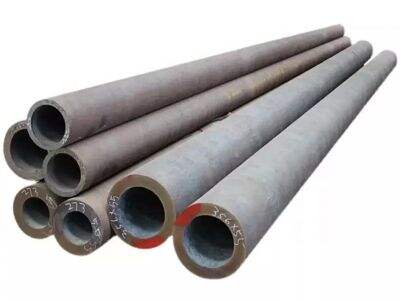Ang mga tubo ng bakal na rustless ay may kahalagahan at maaaring makita sa iba't ibang lugar mula sa mga gusali hanggang sa mga fabrica at kahit sa industriya ng pagkain. Mabango at may mahabang buhay ang serbisyo nila, kaya ito'y mabuting pilihin para sa maraming trabaho. Gayunpaman, hindi lahat ng mga tubo ng bakal na rustless ay magkapareho. Karaniwan, ang rustless mga tubo ng bakal ay may tiyak na trabaho at dumadala sila sa iba't ibang estilo. Sa Jinzheng, naroroon kami upang tulungan kang malaman ang mga ito na iba't ibang uri para maitimpla mo ang tamang desisyon para sa iyong proyekto.
Ano ang Tanso?
Tulad ng iba pang mga bakal na rustless, kinukuha sila mula sa bakal kasama ang mga alloy element, kung hindi babaw 10.5% kromio. Ang kromio ay isang pangunahing bahagi dahil ito ay nagbabantay sa bakal na huwag magrust. Ito ay nangangahulugan na maaaring gamitin ang mga tubo ng bakal na rustless sa mga sikat o mahihirap na kapaligiran nang walang pinsala. Kaya nito maraming industriya ang tumitiwala sa mga tubo at kagamitan na rustless. Ngunit mabuti pa ring ipaalala na maraming uri ng stainless Steel Pipe na may espesyal na gamit.
Kailan ba Mahalaga ang Mga Uri?
Kailangang ipag-uunlad ang pagkakaiba sa mga uri ng pipa ng bulaklak na bakal dahil may sariling katangian ang bawat pipa. Ang mga ito ay maaaring gamitin sa iba't ibang layunin. Halimbawa, ang ilang klase ay mas resistente sa karosihan kaysa sa iba, na mahusay para sa mga lugar na mainit at damo. Iba naman ay maaaring magdala ng malalaking halaga o magtrabaho sa mataas na init. Pagkilala sa mga uri ng pipa ng bulaklak na bakal ay pagsasanay ka nang pumili ng pinakamahusay na pipa tubo na stainless para sa iyong proyekto upang siguraduhin na matupad ang kanyang layunin.
Ano ang Nagiging Espesyal sa Bawat Uri?
Ang iba't ibang uri ng mga pipa sa rustig na bakal ay may iba't ibang katangian na sumasailalim sa iba't ibang trabaho. Ang Rustig na Bakal Klase 304 ay isa sa pinakamaraming ginagamit na uri. Ito ay madalas gamitin sa makamisa ng pagproseso ng pagkain. Dahil dito ay madali ang mapaglinisan, na kung saan dahil ito ay aparato ng pagproseso ng pagkain, ay mahalaga sa ganitong uri ng lugar, at dahil maaari itong tumahan laban sa karosihan nang kamakailan pa. Sa kabila nito, ang Rustig na Bakal Klase 316 ay ginagamit para sa pagproseso ng pagkain upang makakuha ng higit pang resistensya sa karosihan at kakayahan na magtrabaho sa mas mataas na temperatura kaysa sa Klase 304. Pag-unawa sa mga pagkakaiba-iba ay nagpapahintulot na pumili ng uri na pinakamahusay na gumagana para sa iyong mga pangangailangan.
Pagpili ng Tamang Uri para sa Iyong Proyekto
Kung pinili mo ang isang tubo ng bulaklak na bakal para sa iyong proyekto, may ilang mahahalagang mga paktoryal na kailangang isipin. Una, isipin kung saan gagamitin mo ang tubo. Naroroon ba ito sa labas sa ulan o masama na panahon? Isipin mo ngayon kung ano ang tunay na hahawakan ng tubo. Kung papalala ang anyo ng gusali sa mga kemikal o iba pang uri ng mga sustansya, kailangan mo ang isa na resistant sa mga sustansyang iyon. Huli, isipin kung gaano kulot ang tubo. Halimbawa, kung gumagawa ka ng isang tubo para sa isang fabrica ng kemikal, ay maaaring gusto mong magkaroon ng mas resistente sa karat kaysa sa ginagamit mo para sa isang water treatment plant.
Pag-unawa sa mga Numero
Ang uri ng mga pipa sa bulaklak na bakal ay kinikategorize sa pamamagitan ng isang numerikal na antas. Ang mga numero na ito ay nagpapakita kung ano ang nasa loob ng bakal at kumano o resistente ito. Bilang halimbawa, ang kilala mong Grade 304 na bulaklak na bakal ay talagang binubuo ng 18% kromium at 8% nilo. Ang kombinasyong ito ang nagbibigay-daan sa lakas at resistensya sa korosyon nito. Ito rin ay isang super duplex variant na may 11% kromium, 9% nilo, 2% molybdenum. Ang iyong antas na bilang (sa grade) ay nagpapakita kung gaano kadakila ang bakal para sa isang partikular na aplikasyon — hoe mas malaki ang numero, hoe mas eksklusibo ito. Ang pagkilala sa mga numero na ito ay maaaring tulungan kang pumili ng tamang materyales para sa iyong proyekto.
Kaya, sa koponan, kailangang maging maingat ka lalo na tungkol sa uri ng mga tubo ng bulaklak na bawal mong pumili at ang kanilang katangian kahit ano ang iyong mga pangangailangan. Ang Jinzheng ay nag-aalok ng maraming antas ng mga tubo ng bulaklak upang tugunan ang iyong mga pangangailangan. At kung kinakailangan mo bang tapusin ang isang trabaho ng paggawa, paggawa ng makinarya o pagproseso ng pagkain, kakonekta kita sa tamang tubo ng bulaklak. Narito kami upang tulungan ka.

 EN
EN








































